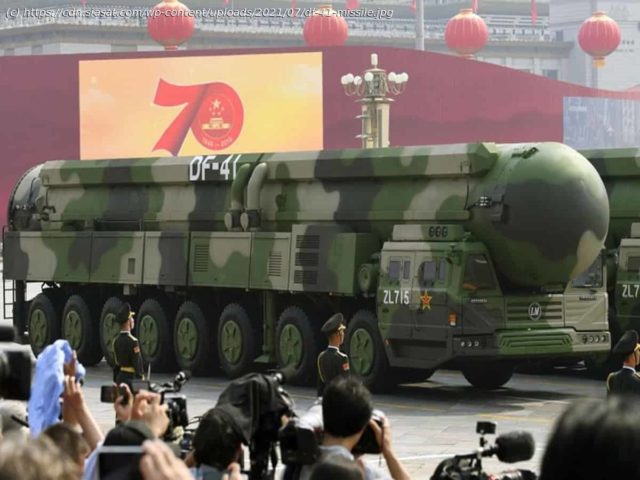Hong Kong: One of the most groundbreaking revelations regarding China’s nuclear missile arsenal was revealed last week
Hong Kong: One of the most groundbreaking revelations regarding China’s nuclear missile arsenal was revealed last week, indicating a pending sharp rise in intercontinental ballistic missiles (ICBM) in the arsenal of the People’s Liberation Army Rocket Force (PLARF). The discovery of 120 under-construction underground silos presumably for DF-41 ICBMs in landlocked northwest Gansu Province was made by Decker Eveleth, an amateur satellite intelligence analyst. He used commercially available satellite imagery from Planet to pinpoint massive amounts of military construction, and his findings on behalf of the James Martin Center for Non-Proliferation Studies in Monterey, California were published by the Washington Post. The site of interest covers hundreds of square miles of desert to the west and southwest of Yumen town in northwest China. The missile launch facilities echo those already known to belong to the PLARF. The site is still under construction, and its scope was described by analysts as “incredible”. With major construction kicking off earlier this year, many of the sites are hidden under 70m-wide dome-shaped inflatable covers, which is typical of Chinese missile sites under construction as they conceal activities and construction details from prying satellite eyes. For those sites without such a cover, workers can be seen excavating circular-shaped pits. There is also evidence of a command-and-control center. The sites are located in two giant swathes, and each site is separated from the other by an average of 3km. Having them in such close proximity with centralized command-and-control facilities and access to maintenance will greatly reduce personnel and maintenance costs. Such silo clusters are different to anything previously seen in China. Previously, for example, the PLA has had entire companies manning liquid-fueled DF-5 ICBM silos in Hunan Province’s countryside. With such a distributed deployment pattern far from maintenance centers, the PLA required a large transport fleet to move fuel, missiles and other equipment backwards and forwards. Having solid-fueled DF-41 ICBMs in close proximity should allow missiles to be deployed at a lower overall cost. The Pentagon estimates that the PLA’s nuclear stockpile is in the low-200s, of which 100 warheads are on land-based ICBMs. Last year’s Pentagon report predicted that these ICBM warheads would reach 200 by 2025. If each new silo near Yumen is to eventually host a missile, this would obviously represent an enormous and historic change in China’s nuclear posture. However, there is debate over whether each silo would actually host a missile, since some could be decoys. Alternatively, they could represent a “shell game”, the conman’s trick of shuffling hidden objects to fool an observer. Thus, China could randomly rotate a smaller number of ICBMs around these silos to keep an opponent guessing. If the shell game hypothesis is correct, it is still impossible to predict the exact ratio of how many silos would receive missiles; various guesses include one missile per eight silos, or even 1:16. The USA planned such a shell game during the Cold War in order to deceive the USSR, but it does come with attendant problems such as how to move and sustain large missiles without being detected. The Carter administration planned to build a staggering 4,600 silos to protect around 200 MX/Peacekeeper ICBMs. The James Martin Center for Non-Proliferation Studies, part of the Middlebury Institute of International Studies at Monterey, said there was “a very good chance that China is planning a shell game”. Eveleth himself mused, “I’m conflicted about the possibility of shell game. There are two big pieces of evidence that I think lend credibility to the theory, but my bottom line is that we should wait and see.” With fewer support vehicles required for the latest DF-31AG and DF-41 TELs, it would be cheaper to deploy decoys too. Eveleth tweeted, “Would not surprise me if they used decoys combined with disguising the real TELs to improve survivability.






